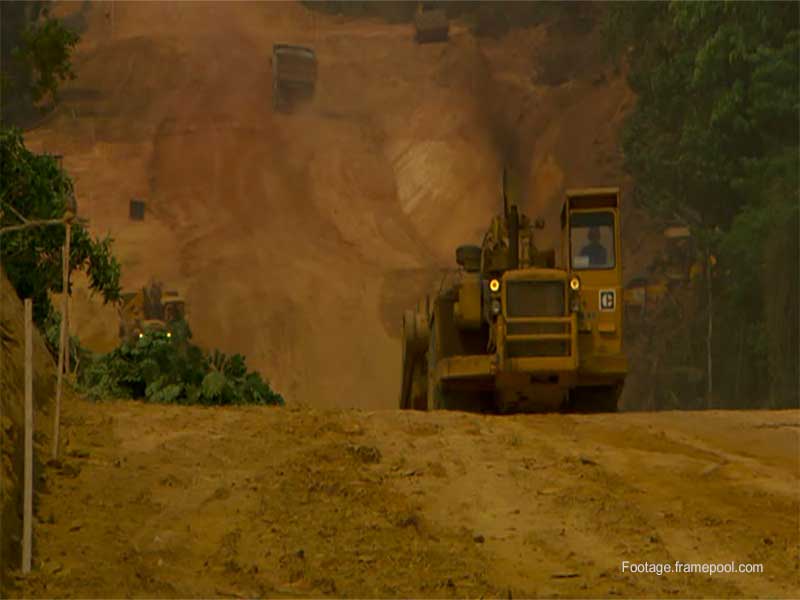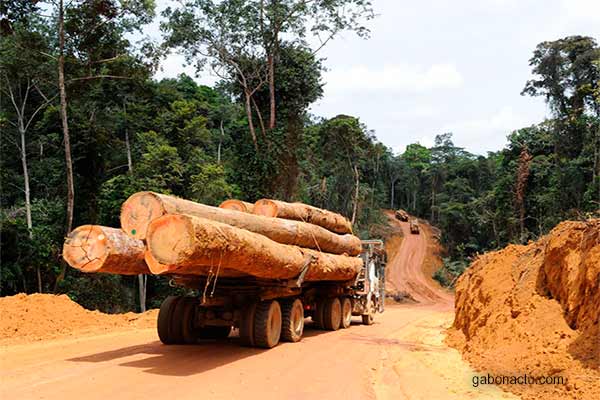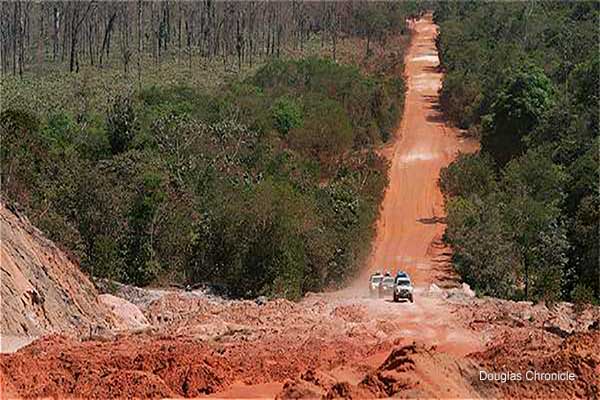Magazine all about Borneo Rainforest
Borneo, a case to reflect
Borneo is the third largest island on the planet, it is larger than France, it is located about 1600 km south of Vietnam and contains the largest rainforest in Southeast Asia. The wooded area of Borneo, described by some as the Asian Amazon, until recently covered almost the entire island with flora and fauna among the most biodiverse in the world. But in the last three decades of the s. In the 20th century, hostile deforestation took place over the forest, making Borneo the largest exporter of wood in the world, even surpassing the Amazon and Africa combined. After that, the rainy forest, where humidity and mud made it difficult to light a fire, became an arid territory prone to continuous forest fires, many of them caused, whose effects have been felt in other regions. Some experts believe that the large forest fires that have occurred in recent decades in distant Australia and Chile are related to the drastic climate change in Borneo.
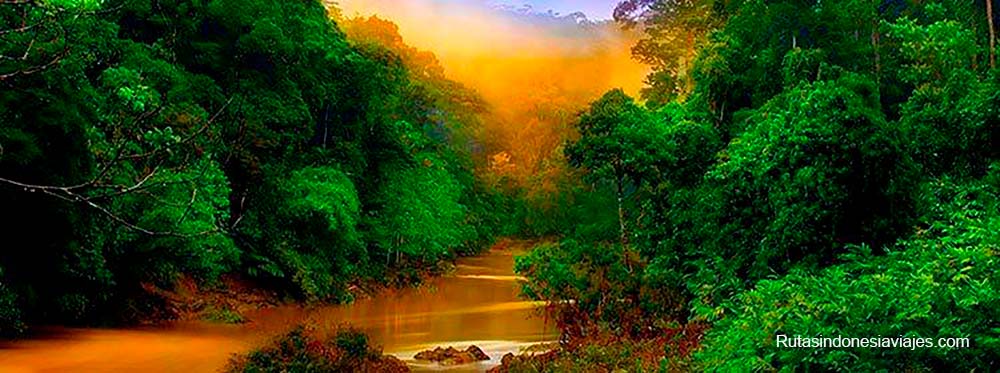
The hostile deforestation of Borneo
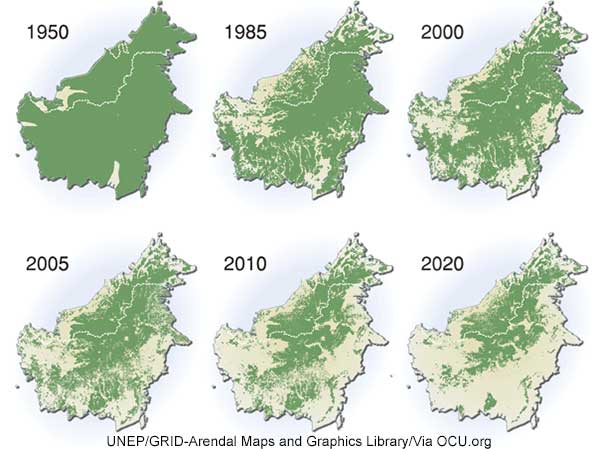
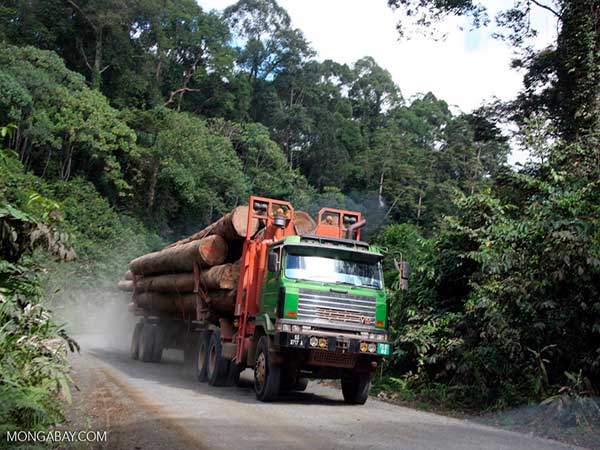
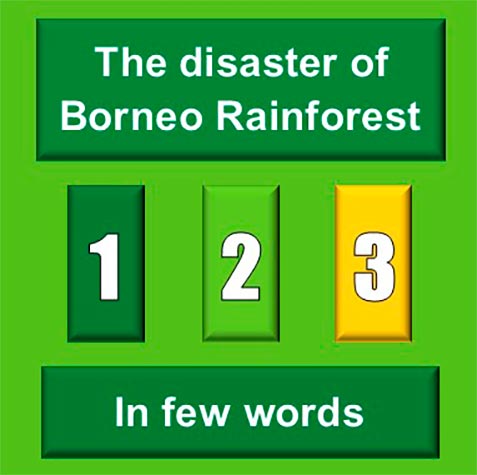
The new oil palm fields are masking the scars left after the massive felling of trees. The jungle is recovering the green color, but not the humidity, the rain or the devastated species.
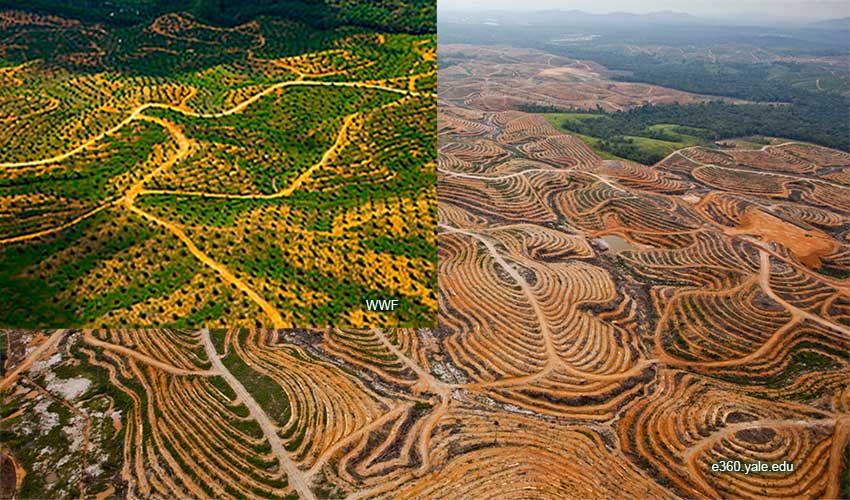
These helical shapes are terraces made with heavy machinery to sow oil palm.
Borneo on the world map
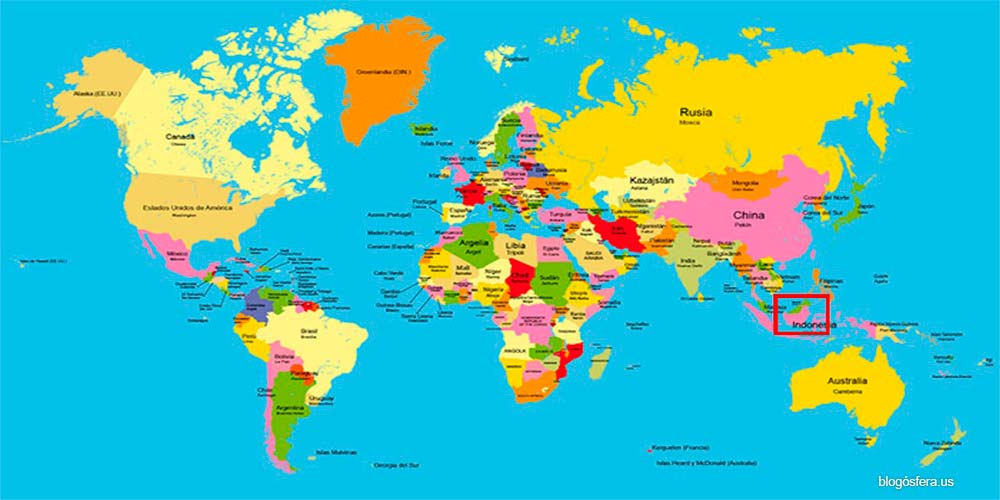
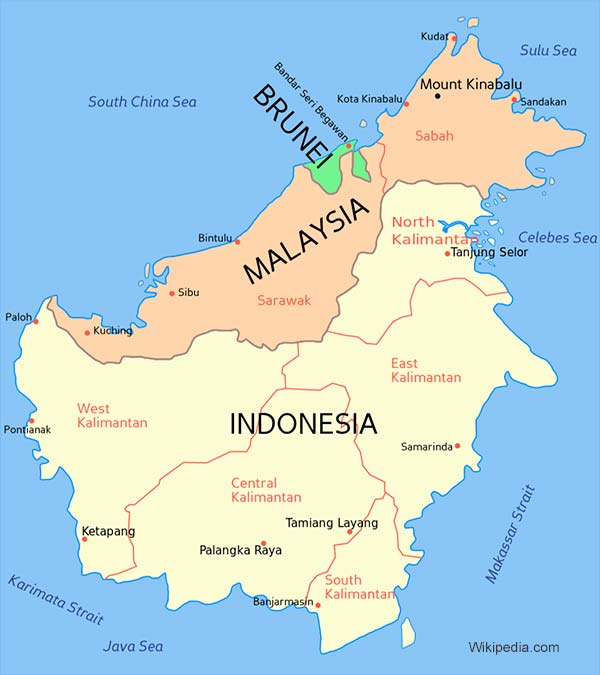
Borneo, with its 743,330 km2, is the third largest island on Earth and is larger than France. Called Kalimantan in Indonesian, Borneo is divided politically into three parts: Malaysia has 26.7% of its territory, Indonesia 72.6% and Brunei less than 1%. The large island is inhabited by about 16.4 million people. Sumatra and Borneo are the only two places on Earth where orangutans live. The forests of Borneo, described by some as the Asian Amazon, in the last 50 years have lost two thirds of their trees and a number of habitats at the expense of the timber industry and other activities that developed with unusual speed on the island.
Geographical location of Indonesia
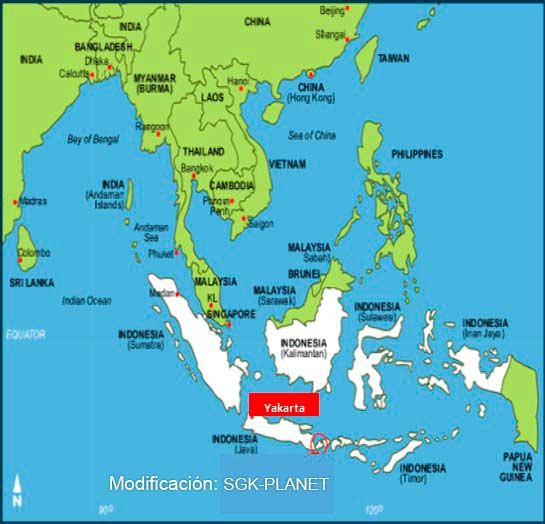
Indonesia fragmented
Pointed in white on the map. In addition to possessing most of the territory of Borneo (72.6%), it is distributed through other 17,508 islands and islets that add up to a population of more than 255 million inhabitants, making it the fourth most populated country in the world, with the more Muslims on the planet. The largest of its islands is Sumatra, the sixth largest in the world, with an area of 473 605 km² and about 50 million inhabitants. Jakarta, capital of Indonesia, with an area of 650 km² is located on the island of Java, being the city with the largest population, with nearly 30 million people in its metropolitan area, it is the fourth most populated city on the planet.
Location of Malaysia
Malaysia occupies 26.7% of Borneo’s territory. Its capital is Kuala Lumpur. Initially, most of the wood was extracted from Malaysia, in the northern states of Sabah and Sarawak.
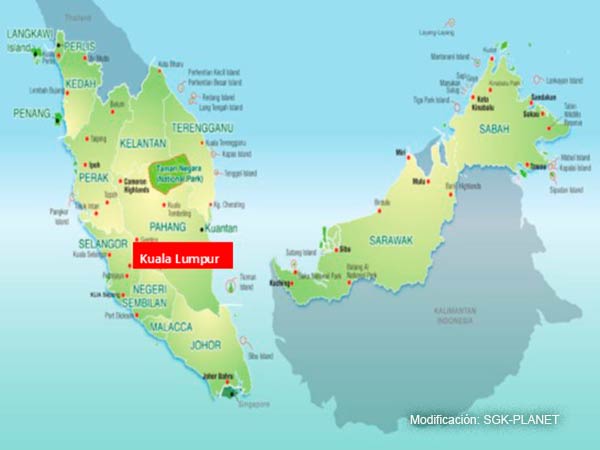
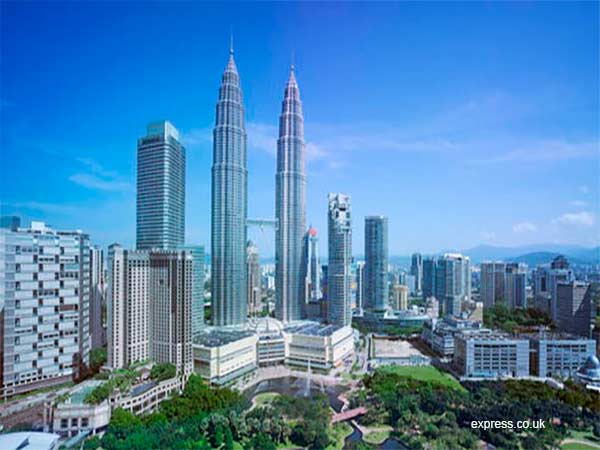
Why Borneo has that immense fertility?
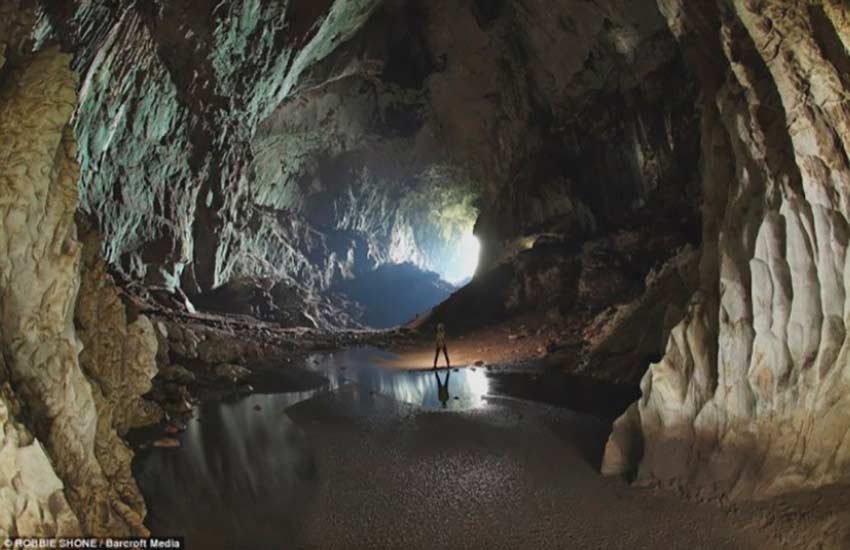
Deer Cave, possibly the largest cavern passage in the world
The island has an extensive grid of rivers and caverns. Deer Cave is thought to be the largest cavern corridors in the world. Borneo has a complex fluvial network with a number of rivers joined to the underground currents, that cross the island, to which Borneo owes its great fertility and its condition of rain forest. The Clearwater Cave has one of the longest underground rivers.
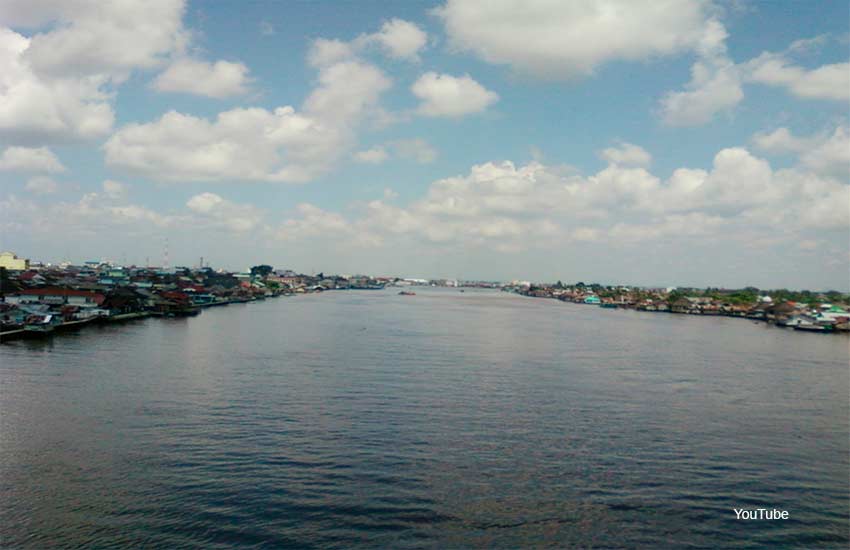
The Kapuas River, the Amazon of Borneo, with more than 1100 km, is the longest in Indonesia
Other main rivers are the Kapuas, with more than 1100 km, it is the longest in Indonesia, while the Rajang River, of more than 550 km is the longest in Malaysia, the Barito of about 880 km and the Kahayan of approximately 600 km long. The Sungai Mahakam of about 980 km, is the main artery through which the wood is extracted, to be dispatched to its final destinations.
Terrifying machines to uproot and transport trees
Tree felling machine in action
Wood transportation process
Tree cutting machine
Truck with huge load on dangerous road
Borneo becomes the largest timber exporter
in the world
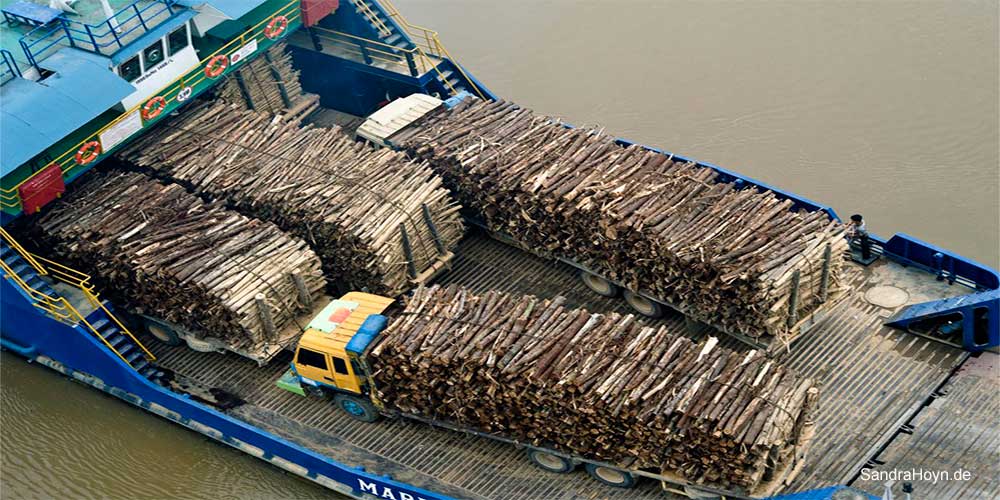
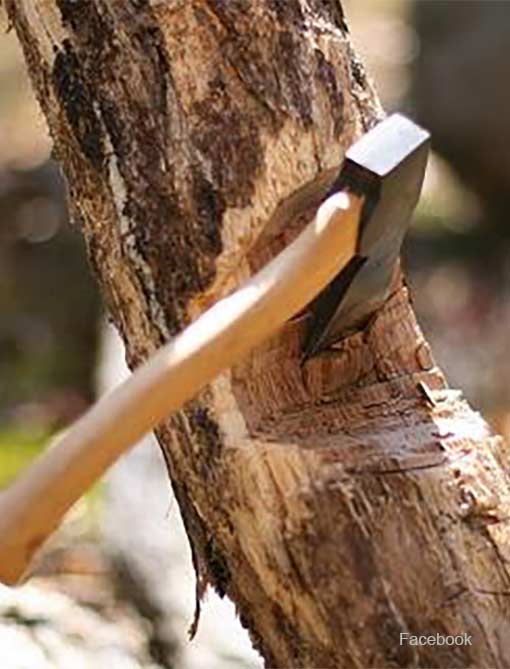
What happened in Kalimantan was not a natural disaster as a result of an earthquake or a hurricane. It was an artificial disaster, since it was the work of Homo sapiens. WWF notes: “Until 1950, 96% of the island was primary forest, while today only 44% remains. The destruction does not slow down, but increases its speed. 25% of the jungle area has disappeared since 1980, and in the whole of Indonesia, deforestation occurs at a rate of two million hectares per year. “Some scientists say that what happened in Borneo is the largest and fastest ecological catastrophe made by man in the history of mankind. According to Greenpeace, the Guinness Book of Records in 2008 pointed to Indonesia as the world champion of deforestation. Borneo is the story of an ecological catastrophe that has not yet ended.
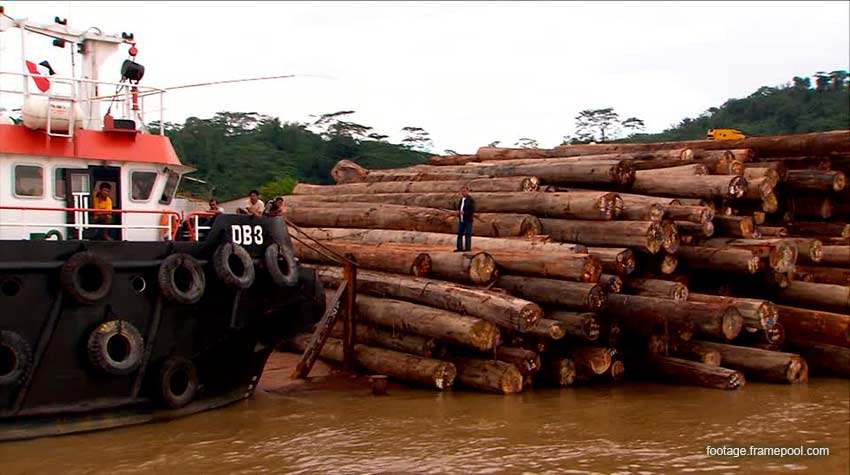
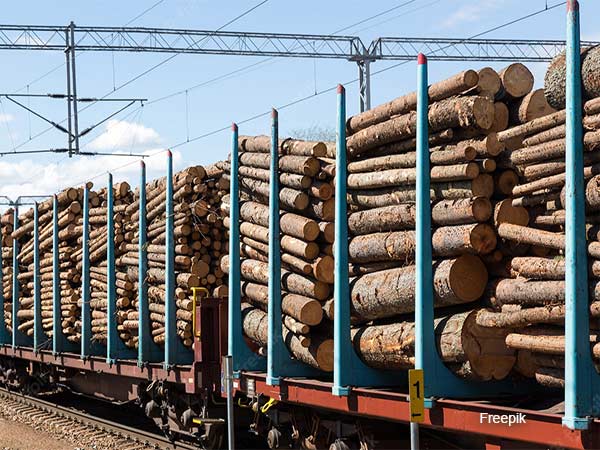
In SGK-PLANET we have written that Borneo is an ecological catastrophe, a nightmare, a horror movie, a mirror to look at us, an example of what should not be repeated anywhere in the world. The recent history of Borneo is the largest and most dramatic case of local climate change produced by human hands. In barely half a century, some humans destroyed what it took nature to build millions of years. The damages are irreversible. The great lung of Asia has been seriously compromised.
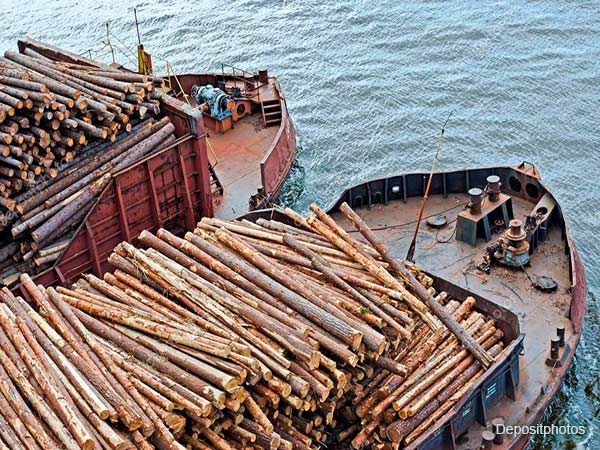
Initially, most of the wood was extracted from Malaysia, in the northern states of Sabah and Sarawak. Then, the forests of southern Indonesia became the main source of tropical timber. Industrial timber trade took off in the 1970s. According to Mongabay, “Indonesia’s President Suharto distributed large tracts of forest to consolidate his political relations with army generals”.
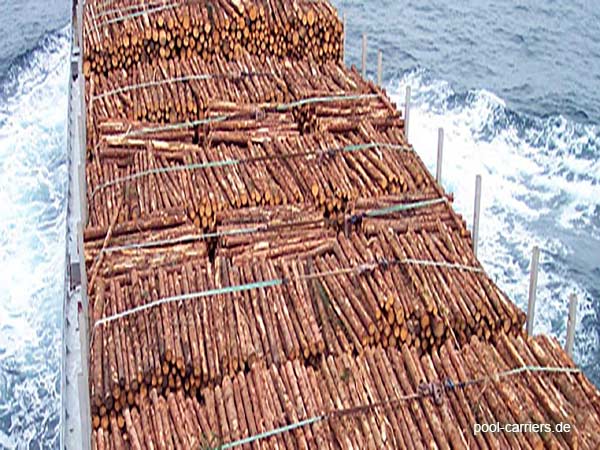
The trees, extracted, left huge spaces on the island, which were occupied with the sowing of oil palm, known for its negative environmental impact, such as soil degradation, habitat loss and species extinction. Shortly after Suharto stepped down from power in 1998, a complex web of powerful families, politicians, corruption and corporations was formed, whose focus was on the oil palm business, which led to the second wave of forest destruction, which has not stopped until today.
The addiction to wood
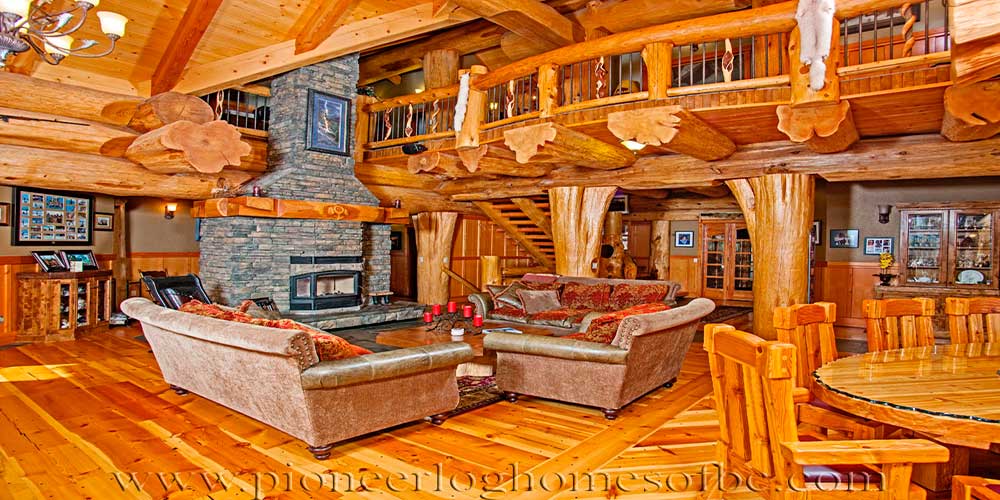
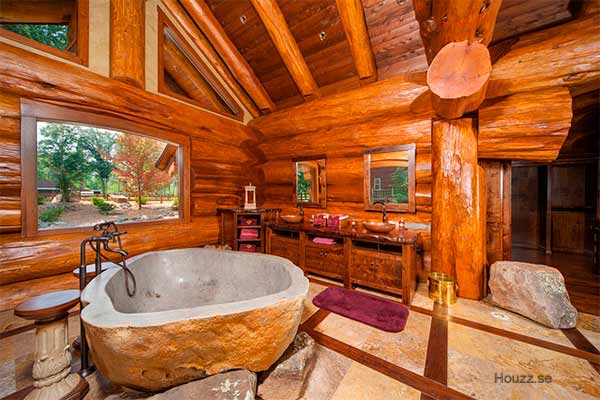
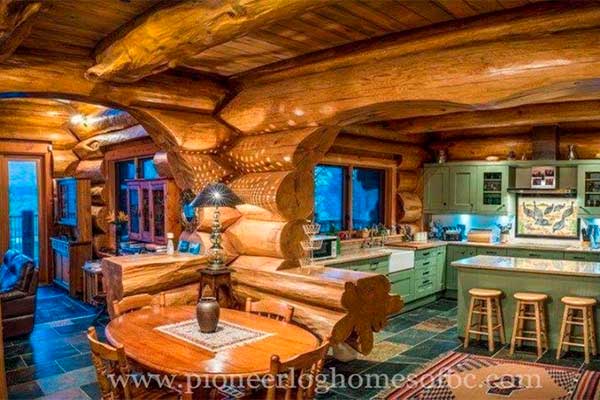

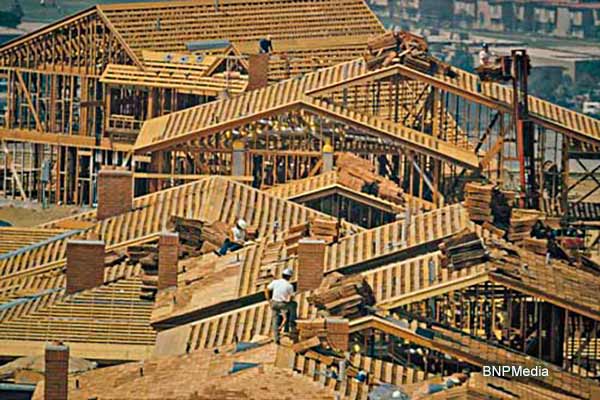
Is wood sustainable to make paper?
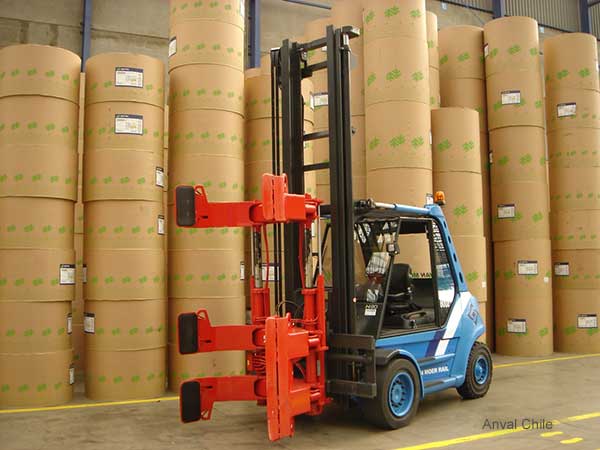
“The paper industry is at the top of the ranking in terms of the use of natural resources and generation of pollutants, all to produce a product that is usually discarded immediately. Paper accounts for about 40% of total urban solid waste in some industrialized countries. Despite the modernization of its industrial processes, the demand for land for plantations, the intensive use of water resources, the volumes of liquid discharges, its gaseous emissions and solid waste make this industry a danger that is expanding in all regions of the planet.”
Greenpeace
Consequences of disappearance of lung of Southeast Asia
Trees produce oxygen, a vital element for most species, and in turn absorb carbon dioxide (CO2) the largest component of greenhouse gases, causing global warming and its consequence climate change. During photosynthesis, the process carried out by trees and a large part of plants, they absorb and store CO2, which is fixed to their roots, trunks and leaves in the form of carbon. The plants, although they take oxygen from the air and re-enter CO2, the final balance is positive in favor of the extraction of CO2 from the atmosphere. The absorption capacity is proportional to the size, density and quantity of plants and trees present in a forest.
Since most of the trees have been felled, the Borneo rainforest has reduced the amount of water vapor that it releases into the atmosphere, reducing the clouds, humidity and rain that irrigate the forest itself, as well as its areas of influence, increasing the drought and the fires even in remote places. There are scientists who think that the increases in number and intensity of forest fires have to do with Borneo changes.
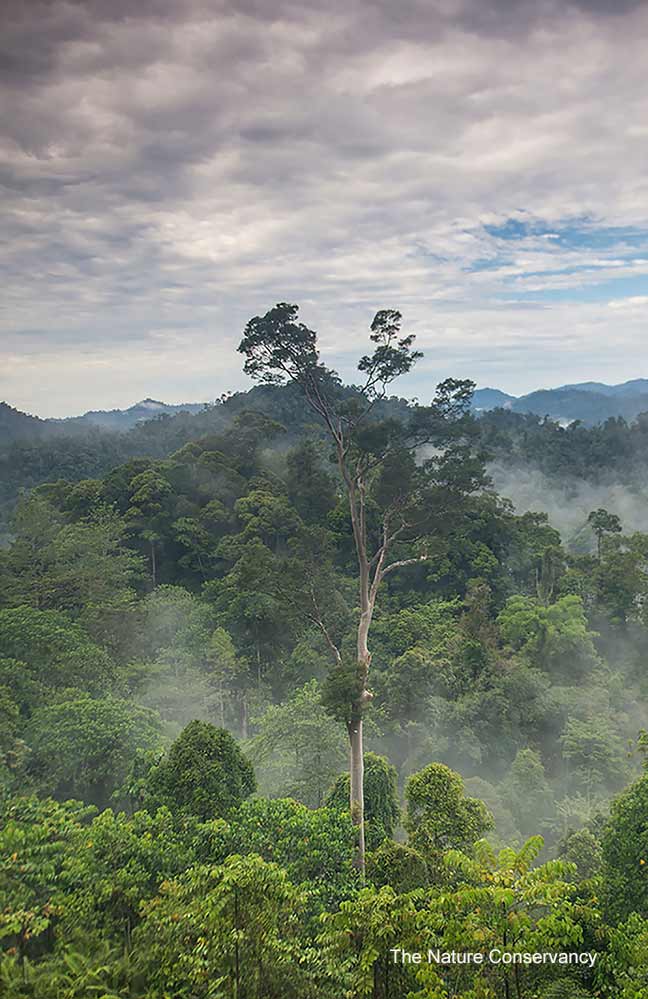
Fire and extreme smoke in Borneo
seen from space

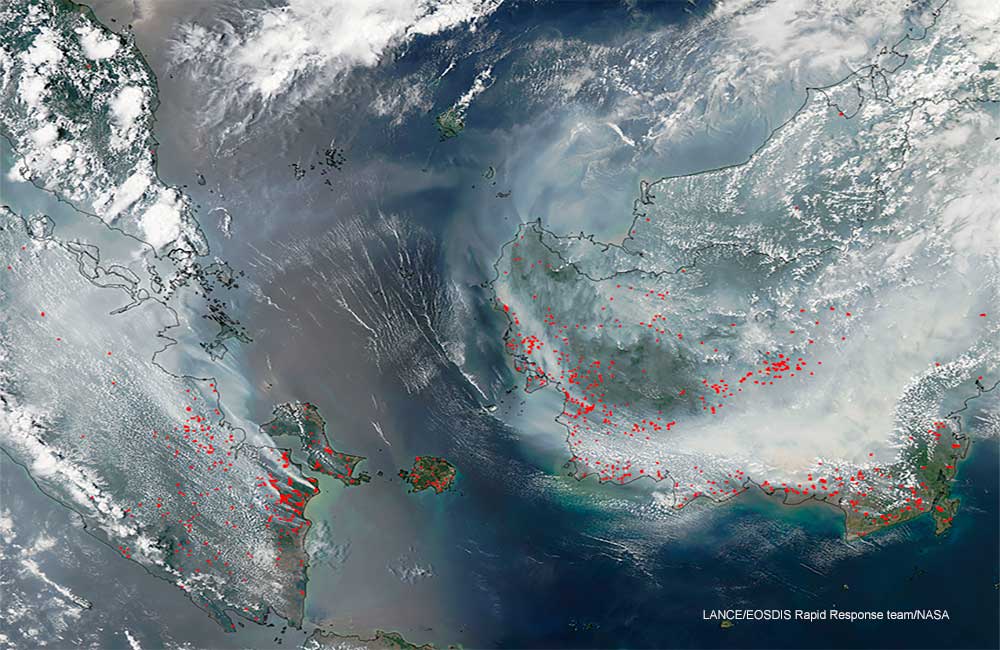
Stunning satellite image of NASA shows the fire points and clouds of smoke in Borneo and Sumatra
There are scientists who think that the increases in the number and intensity of forest fires have to do with changes in Borneo.
The dense and large amount of smoke generated by these fires is recorded and how its movement affects the Asian continent, even going around the planet.
Trees replaced by palm oil
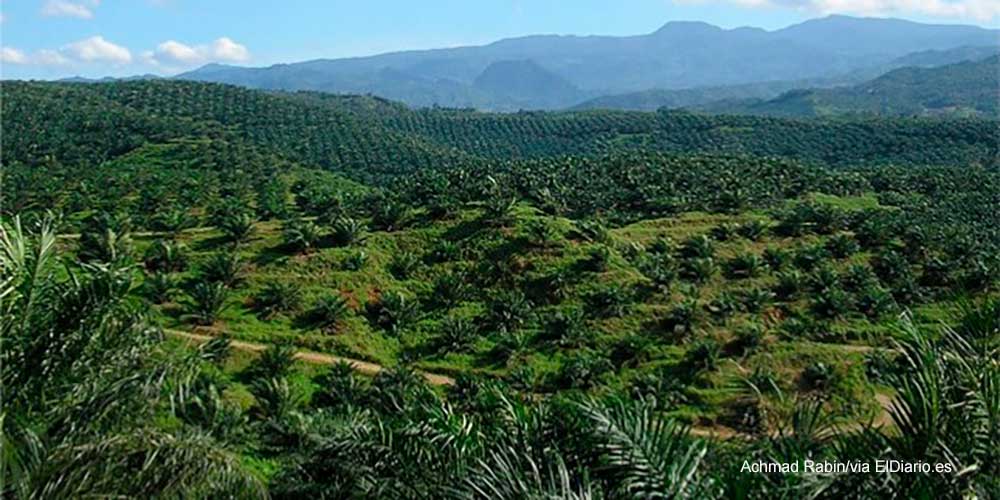
The sowing of oil palm may camouflage the scars left in the jungle by the disaster that resulted in the felling of millions of trees. You can green the landscape and show that nothing has happened there. But it will never be able to restore quality to the earth, the humidity in the air, the rains that generously watered the island and its surroundings for millions of years. Nor can it revive the animals and plants that have fallen due to deforestation or the habitats destroyed in less than 30 years, much less the extinct species.

Palm oil is one of the best selling oils in the world, fighting the first place with soybean oil. However, it is the crop that grows the most globally with an upward trend. The oil palm is a plant that in a single hectare can produce about 6,000 liters of crude oil, several times higher than that obtained with soybean oil or corn oil, which makes it very profitable.
La palma de aceite es una planta que en una sola hectárea puede producir unos 6.000 litros de aceite crudo, varias veces superior al obtenido con aceite de soja o aceite de maíz, lo que lo hace muy rentable.
Palm oil is worse than you thought
Palm oil problems
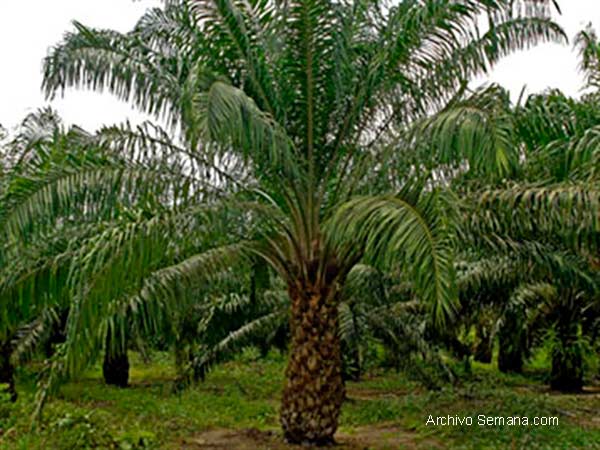
The oil palm is an oil crop that produces more raw material per unit area. One plant can be planted very close to another and it grows even on burned and degraded lands.
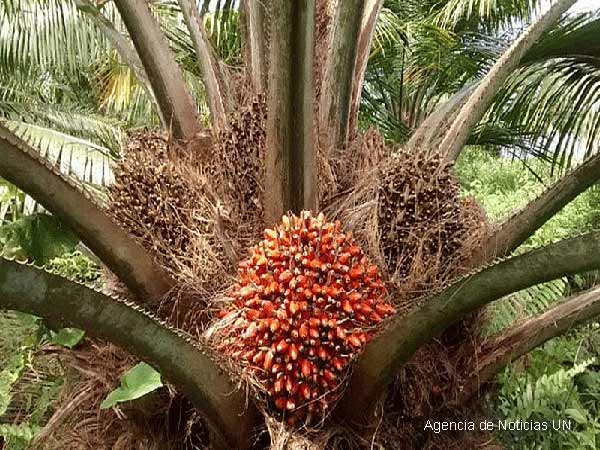
The oil palm is native to West Africa, from which oil was obtained 5,000 years ago, from where it passed to America, introduced after the voyages of Columbus, and in more recent times was introduced to Asia from America.
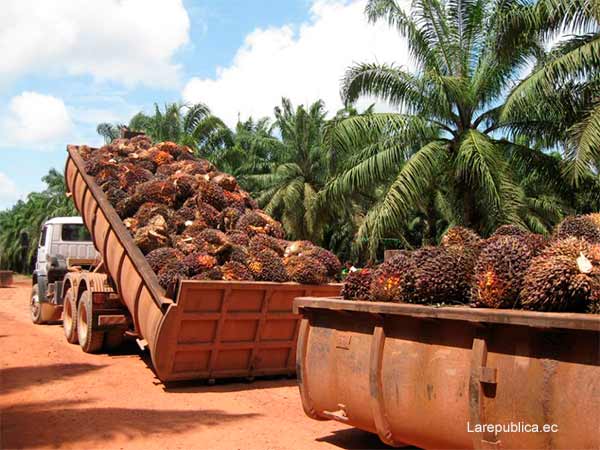
The fruit bunches of the palm are harvested manually and occupy large volumes due to their high production. In Borneo it is transported by land and river.

The fruit of the palm is slightly red, like the unrefined oil. After refining acquires the characteristic color of the oil.
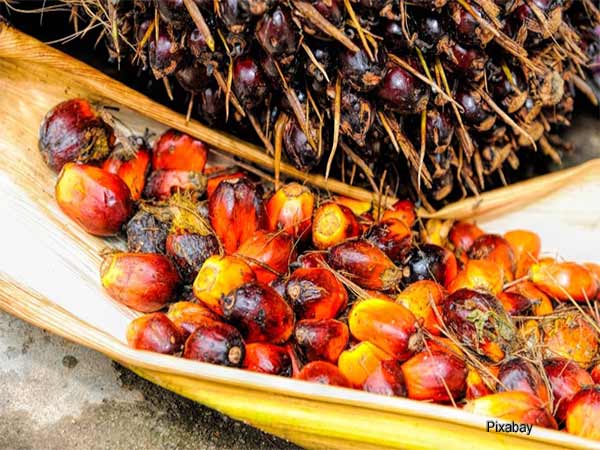
The uses of palm oil in the home are mostly culinary. It is used directly as frying or dressing oil, like any other oil to add to other foods.
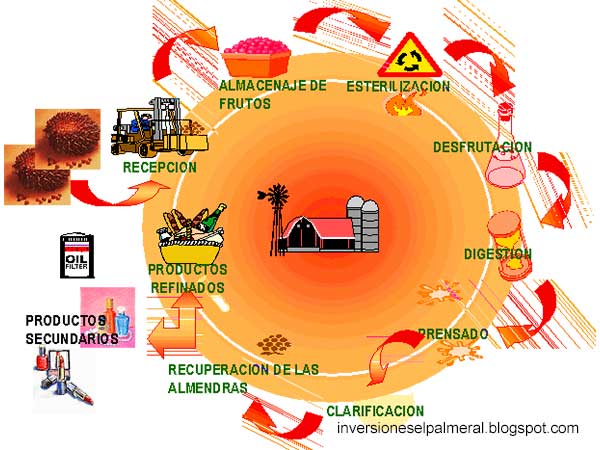
Palm oil manufacturing process. In the infographic the different steps are observed, from the reception of the fruit to the exit of the refined products.
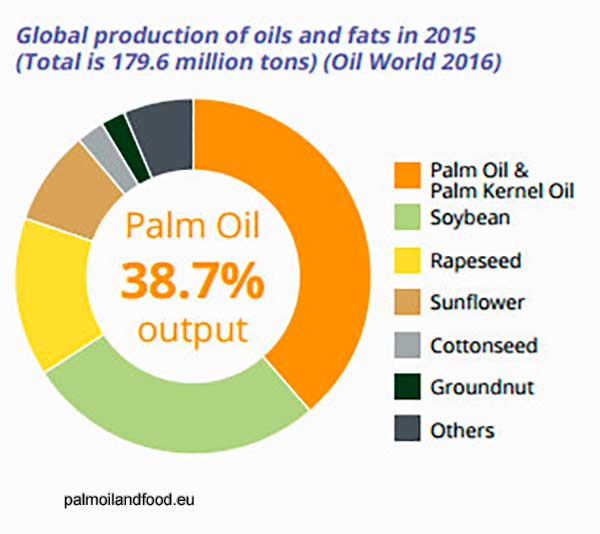
Main uses of palm oil
Creams and coverages
Spreadable products
Chips and snacks
Snacks and cakes
Precooked foods
Cleaning products
Soaps
Cosmetics
Candles
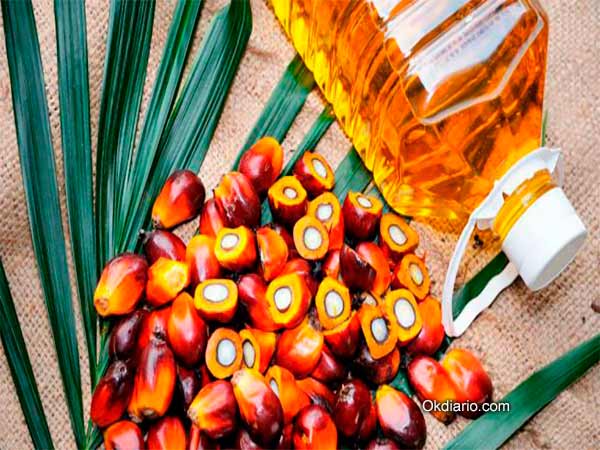
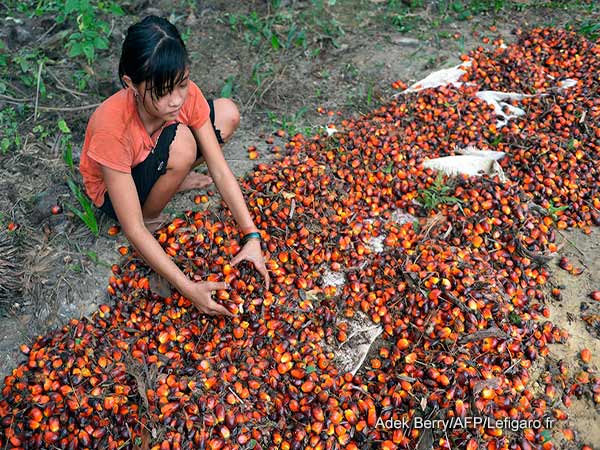
Effects for health
According to studies by the Center for Science in the Public Interest, excessive consumption of palmitic acid (44% of palm oil) increases cholesterol levels and can contribute to the development of cardiovascular problems. The World Health Organization and the National Heart, Lung and Blood Institute of the United States advise limiting the consumption of palmitic acid and foods with a high content of saturated fats. According to the WHO, there is evidence that the consumption of palmitic acid increases the risk of developing cardiovascular diseases, placing it at the level of evidence that saturated fatty acids. (Wikipedia)
Borneo, from incombustible rain forest
to dry land burned down
Why are there so many forest fires in Borneo?
Burning is the most economical method to clear land for planting. After an area is deforested, the plant remains are burned. As the oil palm has a surprising adaptation to the scorched earth, they found that this plant was the ideal one to replace the felled trees. The fire was also used to evict the occupants of lots in the struggle for possession of the land. These fires are used in a controlled manner, but they often get out of control, especially during droughts, spreading rapidly and forcefully, burning large areas of forest. In 1997 and 1998 two of the worst fires in Indonesia occurred up to that time. Losses devastated more than 10 million hectares of forest, causing serious health problems for the population and affecting the tourism industry.
Somewhere in Borneo. Only 50 years ago on the island there was a humid, rainy forest, in some parts full of mud where it was difficult to light a fire. Today there is not a day without dozens of fires.
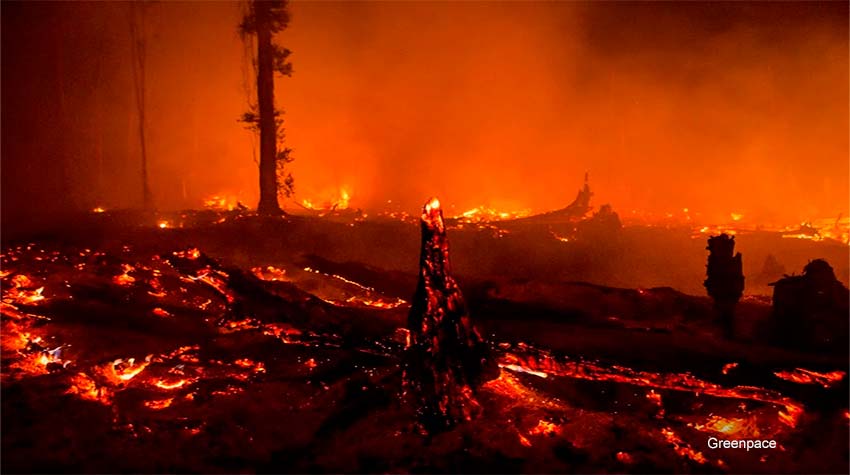
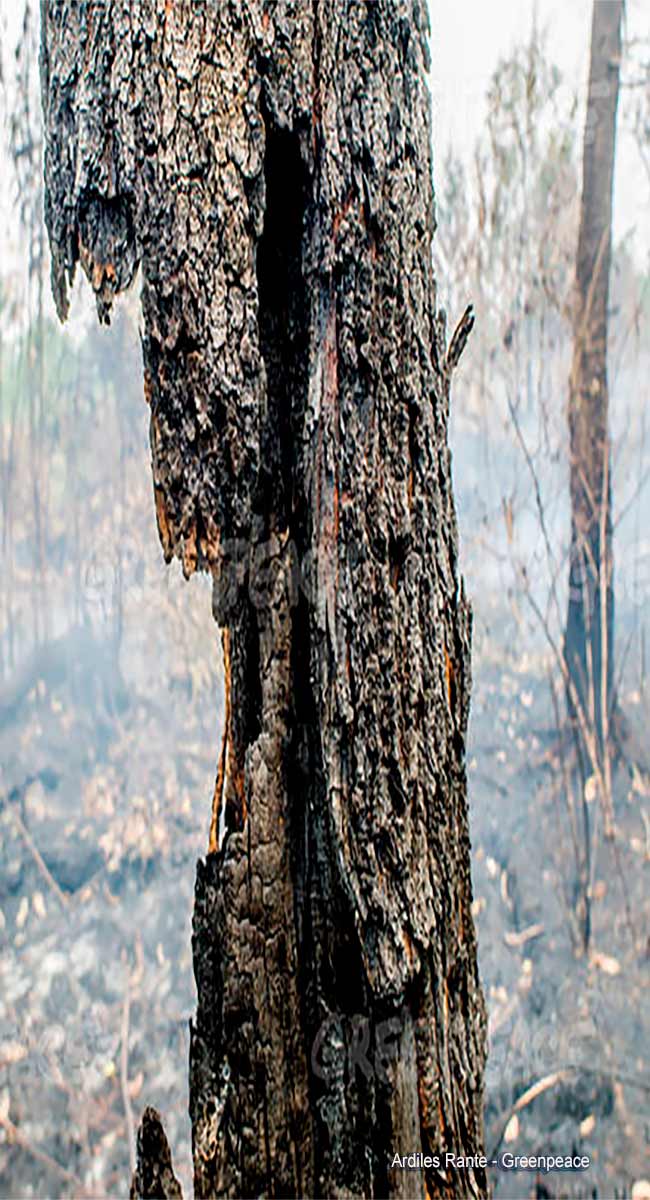

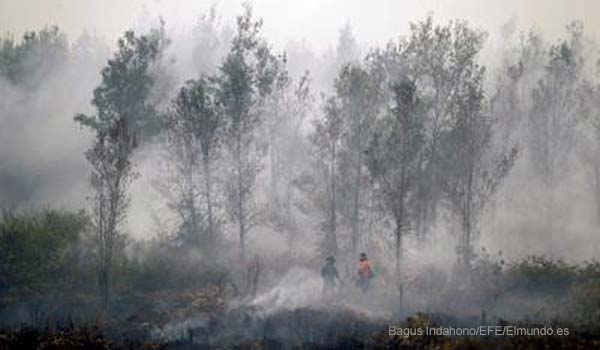
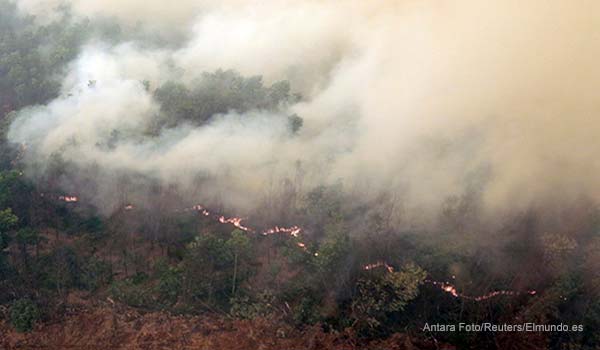
The fires do not stop
Jakarta, Feb 22. Indonesia declared a state of emergency on Monday in view of the possible worsening of forest fires in several provinces of the island of Sumatra and areas of West and Central Kalimantan, island of Borneo. The spokesman for the National Agency for Disaster Mitigation, Sutopo Purwo Nugroho, reported that the satellites detected 90 hot spots, mostly located in West Kalimantan, and that personnel from the agency, the army, police and volunteers work to control the situation.
(News of 22-02-2018 – Prensa Latina).
From what planet are these strange formations?
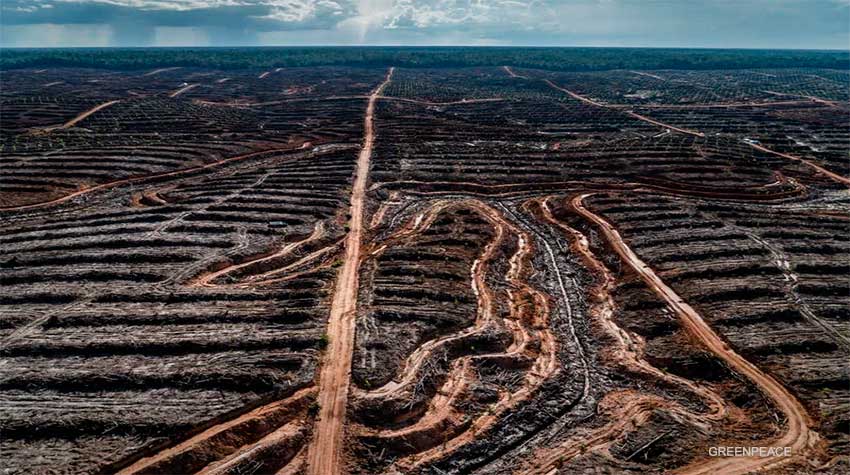
They are from the Earth, from Borneo, they are forests of bogs burned intentionally
But this is still not the worst. Borneo peat bogs retained immense amounts of carbon – Mongabay explains – that were released during logging to clear the land for plantations. In the south of the island much of this jungle grew in peat bogs, composed of deep layers of organic matter accumulated over thousands of years. To plant in peat, palm oil producers dug huge ditches to drain the water. This caused them to decompose rapidly, which released powerful greenhouse gases into the atmosphere. The dry peat was also highly flammable. (…) In 2006, Indonesia experienced one of the worst seasons of fires that are remembered, when smoke from fires by Sumatra and Kalimantan triggered a carbon bomb and covered the region in a thick haze visible from space. That year the fires carbonized a thousand orangutans.
The orangutan, the emblematic victim of the Borneo tragedy
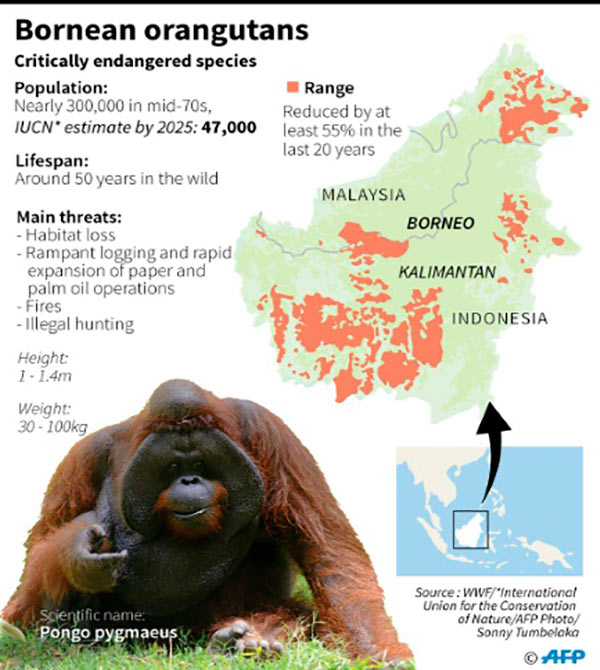
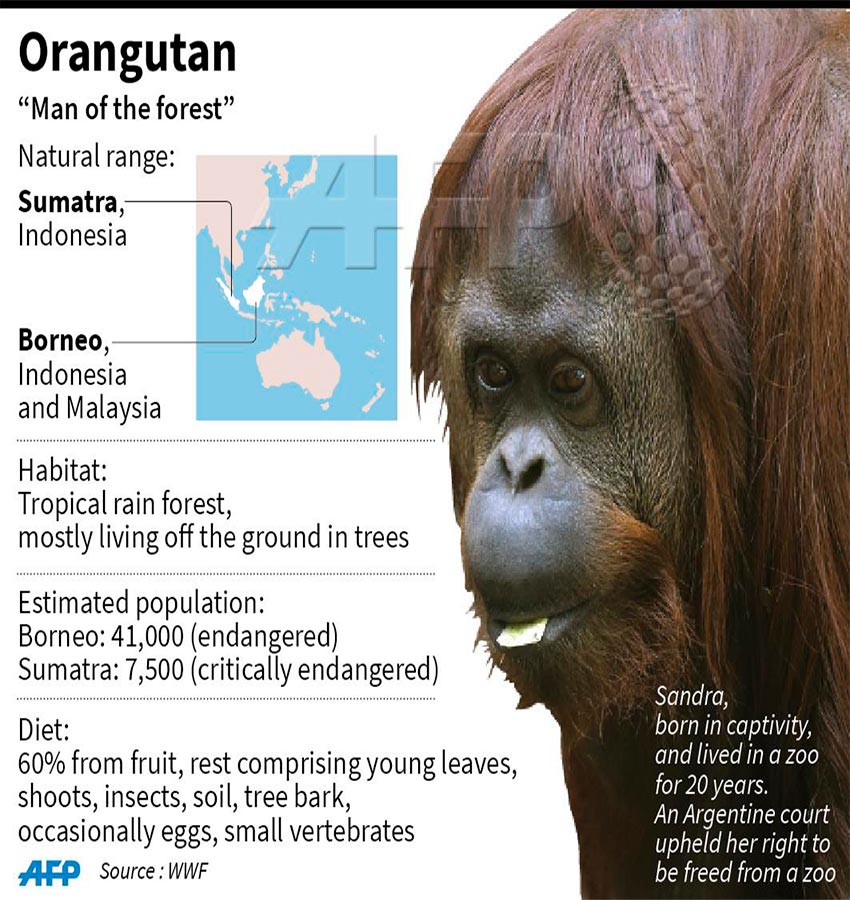
The orangutan has a life expectancy of 30 years, the same period in which the great deforestation of Borneo occurred. In three decades these groups of apes saw forests disappear that had served as refuge and food for their ancestors for hundreds of thousands of years. When the trees were felled and the subsequent intensive burning of the forests, Borneo became a hell for the orangutans. Disoriented, without a home or food, they fled to the agricultural areas, seeking to subsist on the fruits of the oil palms, to which they were already adapting.
But instead of finding the sustenance they were looking for they found themselves face to face with the firearms of the humans, who considered as a plague the noble animals to come to steal their crops. They were shot down with their rifles in an asymmetric, cruel and inhuman killing, which should be considered a crime against nature. In August 2006, the Wildlife Conservation Society (WCS), through its program in Indonesia, stated that the population of orangutans in that country was 20,000 animals, against the 35,000 that were in 1996. Due to its low reproductive rate, some environmental groups have warned that the red ape could become extinct in nature if urgent measures are not taken for its conservation.
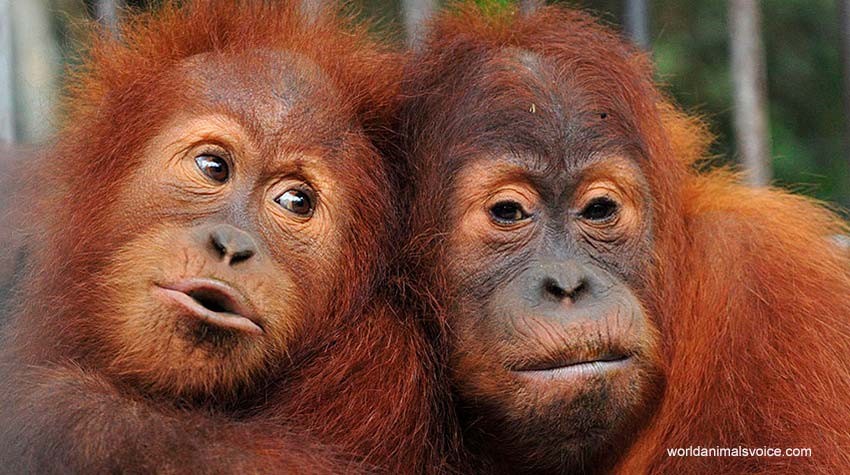
The only two places where orangutans are found are Borneo and Sumatra, two large neighboring islands. Now the orangutan is a threatened species.
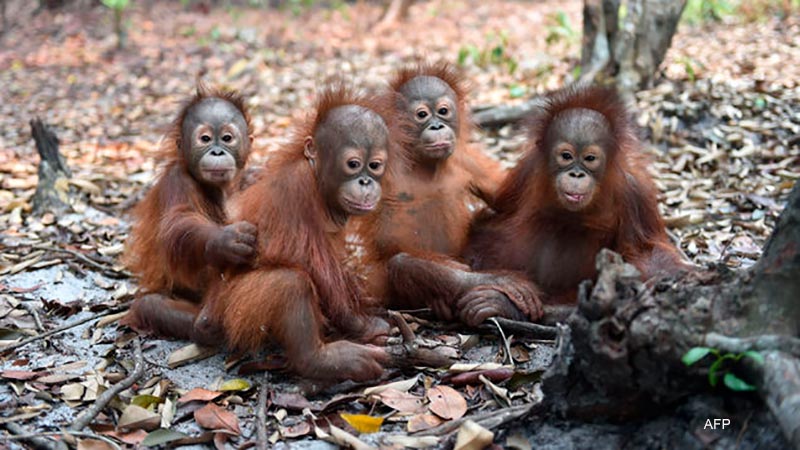
“Kalimantan authorities complain of lack of resources and the orangutan center criticizes the little progress made since 20 years ago in the fight against fires.”
Telemetro.com
Young orangutans sitting in the ashes after the fire. They have lost their trees where they spent 90% of the time. They have remained on the floor, perhaps orphans, at the mercy of predators. Orangutans saved from fires go hungry, wander disoriented and dehydrated, until the most fortunate are found by organizations that welcome them and help them survive.
Borneo already had its local climate change
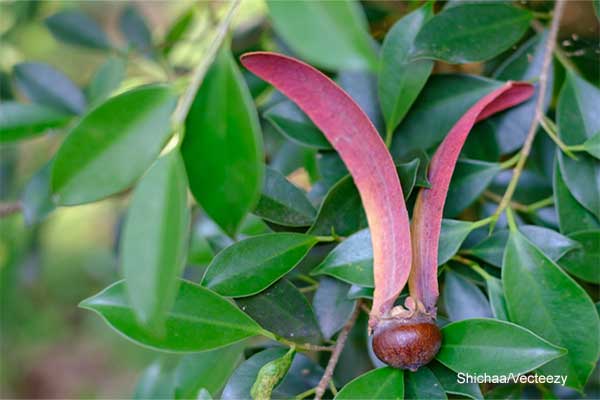
Flowers and seeds of dipterocarps
Very important to understand Borneo’s problem
In contrast, in Borneo, the arrival of the Child had a positive effect. According to Dr. Lisa Curran, a renowned scientist who spent twenty years studying its climate on the island, the flowering of the dipterocarp forests gives Borneo a special dynamic. Curran notes that “between 80-93% of the species synchronizes its flowering with drought, which normally occurs every four years.” During a “dipterocarp year”, in Kalimantan, the whole forest fills with color, when countless trees -each one with about four million blossoms- flowers during a period of six weeks (…) “.
This massive flowering and the subsequent budding of the fruits represented a great advantage for the seed predators during the particular season, especially for the wild boar, a great consumer of them. The increase in the number of wild boars created such an abundance during these periods, that the population of Borneo considered the El Niño phenomenon as a blessing, since its inhabitants collected enormous quantities of seeds for export and were supplied with abundant wild boar meat. “This relationship has existed since human beings inhabit Borneo, and is rooted from the tribes inside the forest to the merchants on the coast,” Curran adds.
But the situation changed drastically and El Niño has the same negative effects as in other regions, after the intense deforestation of the forests occurred in the decades of 1980-1990, during which Borneo became the largest exporter of wood in the world . The brutal destruction of the rainforest so shocked the cycle that “seed production was reduced from 175 pounds per acre in 1991 to 16.5 pounds per acre in 1998, even though it was one of the strongest El Niño years It seems that logging has reduced the density and biomass of mature trees below the critical threshold that limits mass flowering. ”
Homo sapiens became one of the largest rainforests in the world, one of the most important reservoirs rainy on the planet, where just half a century ago the humidity and mud made unimaginable a forest fire, in an arid, dry and hostile place not suitable for animals or vegetables in most of its territory. Borneo is a very serious case of human unconsciousness regarding the environment. Homo sapiens intervened in Borneo and produced a clear and irrefutable local climate change. This serious case should not be overlooked.
Borneo ecosystems
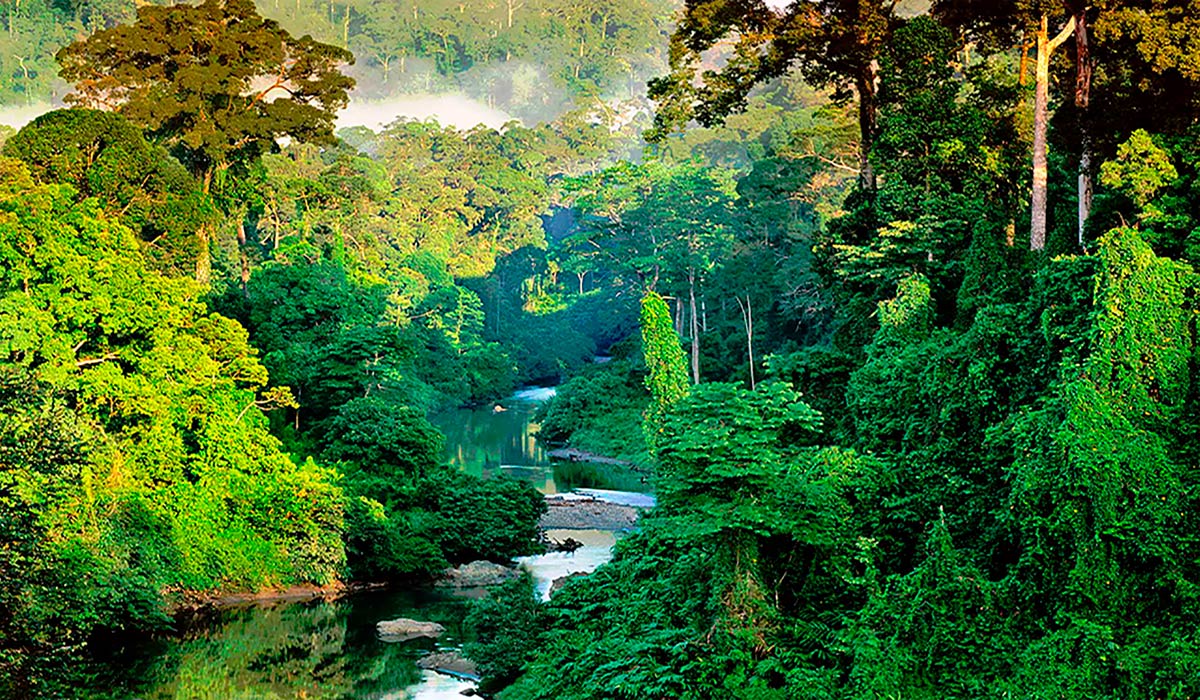
Borneo has 15,000 species of plants (6,000 endemics). The mangrove is found in coastal regions. With an estimated extension of 1.2 million hectares, it occupies only 20% of its original extension. The peat swamp forests covered more than 10 million hectares in 2002 and we have already seen the consequences of the human intervention to which they have been subjected. The mountain forests, or montanos, occupy the high areas of the island. In 2002 it was estimated that about 70% of the original mountain forests remained. The forests of dipterocarps are the most biodiverse of Borneo, although they are also the most threatened. More than half of the original area covered by this ecosystem has been deforested in Malaysia, and about 70% in Indonesia.
Mangroves
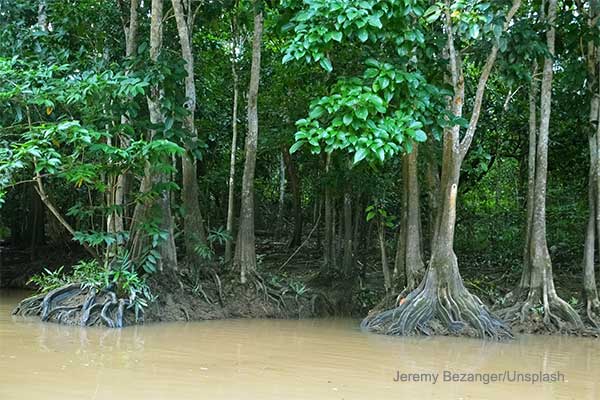
The mountain forests
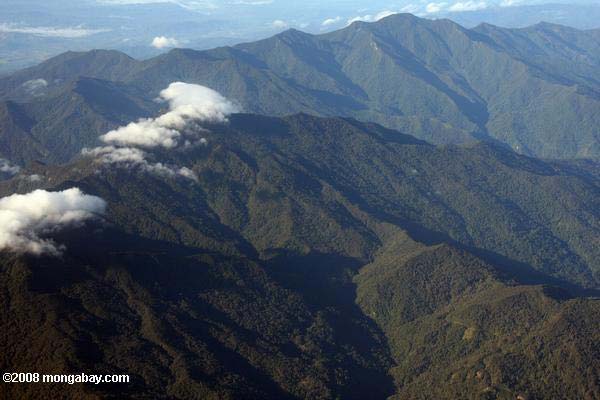
The Dipterocarps forest
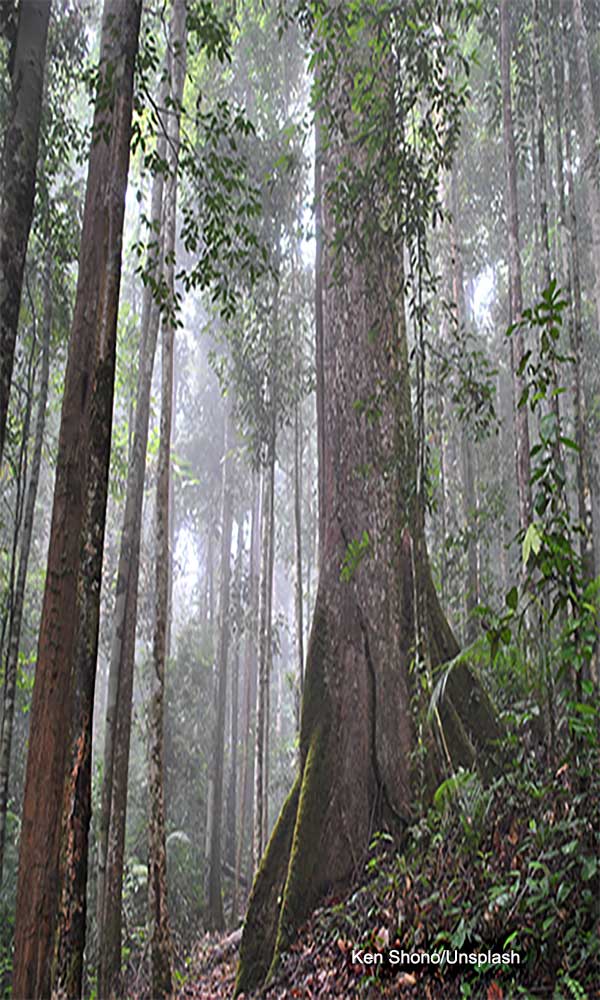
The Peat swamps
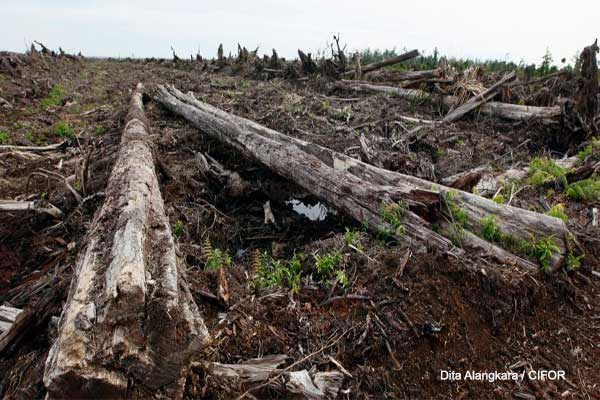
Raffleasia, giant flower more than one meter
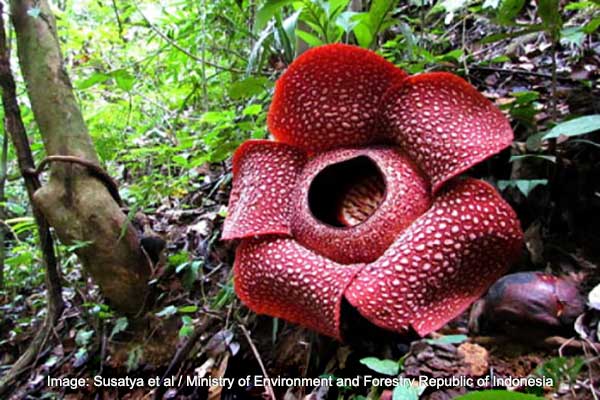
Borneo Wildlife
In Borneo there are about 420 species of resident birds (37 endemic); 100 amphibians; 394 fish (19 endemic). Among the birds, the eight species of calaos stand out, symbols of the island due to their quantity, variety, size and color. As for the insects, in a single dipterocarp tree have been found 1,000 different species. All have suffered major declines in their population due to the destruction of their habitats during deforestation and fires on the island. It is difficult to quantify the number of casualties and perhaps you will never know how many died in the big fires or in their failed attempts to adapt to the island’s new vegetation cover, especially oil palms.
Clouded Leopard
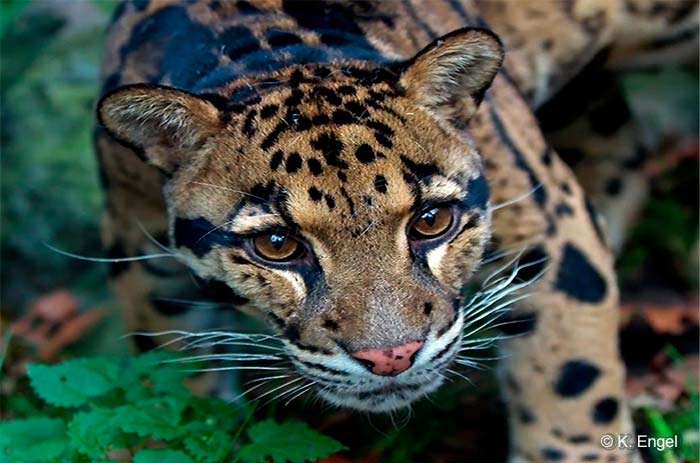
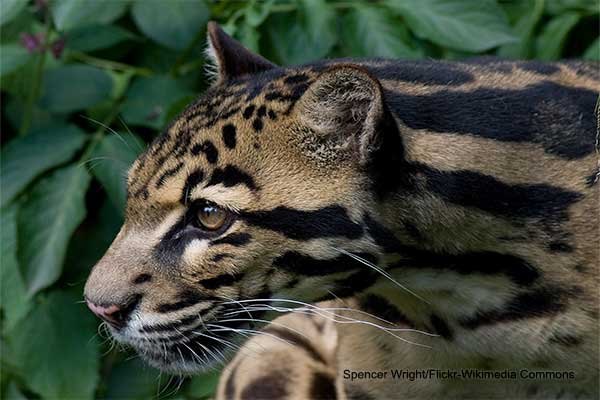
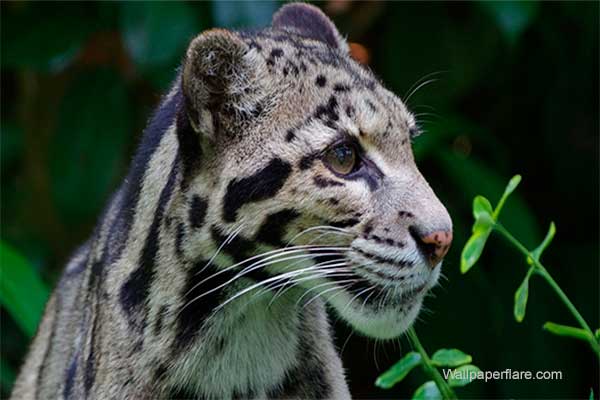
CITES considers that the hazy leopard is in serious danger, so it expressly prohibits trade in these animals.
Probóscide Monkey
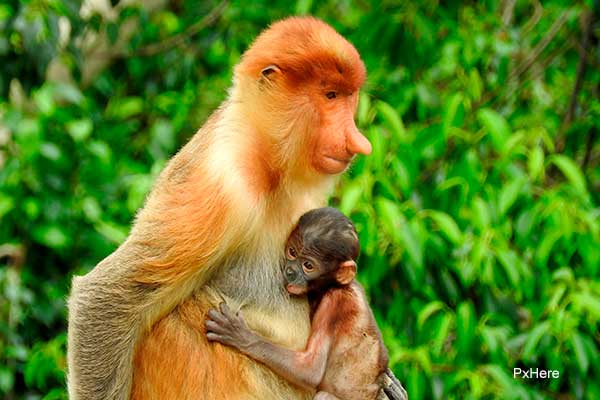
Gibón of Müller
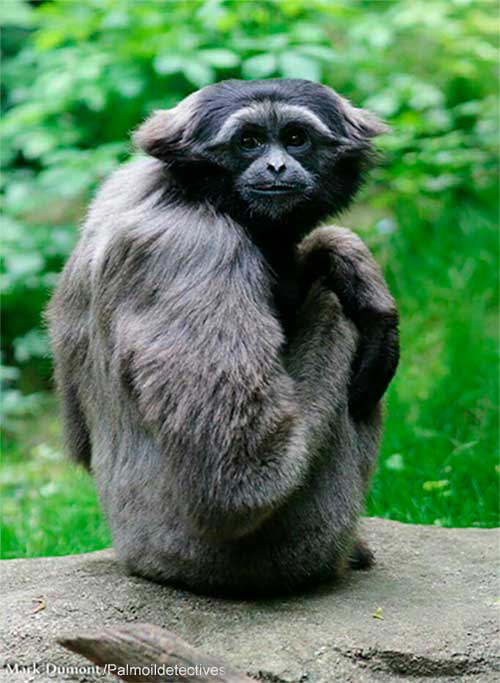
Malaysian Bear
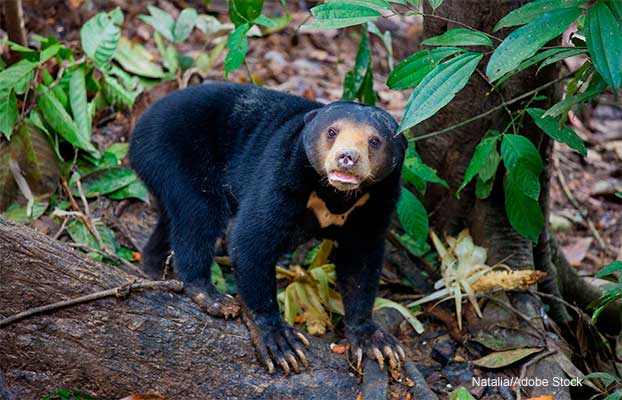
Borneo pygmy Elephant
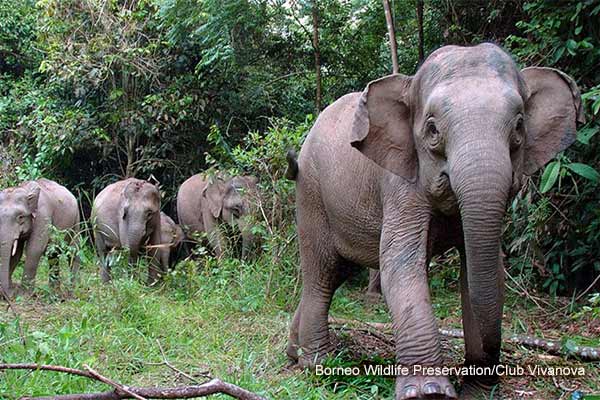
Borneo pygmy elephant is concentrated in the jungles of Sabah. It is currently in danger of extinction, because there are no more than 1000 copies.
Borneo Rhinoceros
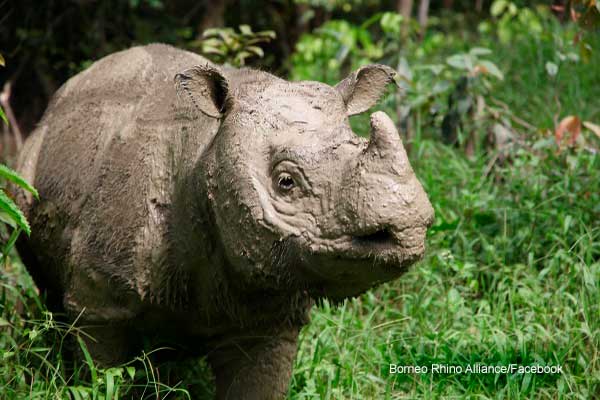
The hunting and destruction of Borneo rhinoceros habitat makes it run a serious danger of extinction.
Calaos
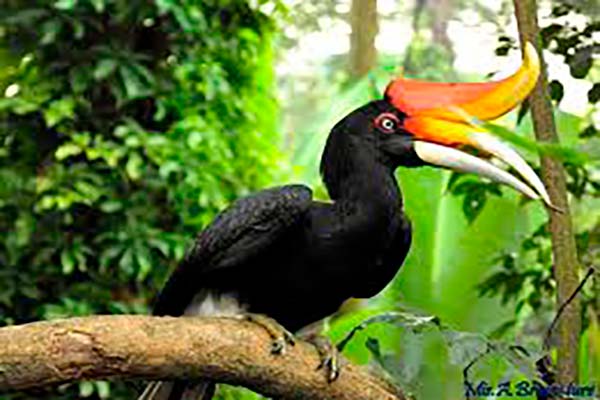
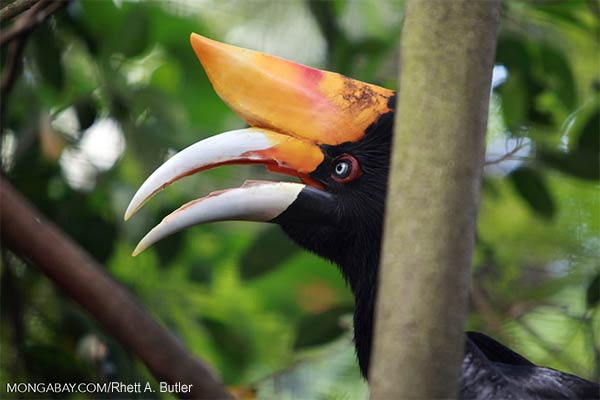
Among the birds, the 8 species of calaos stand out, symbols of the island due to their variety, size and color.
What is CITES?
CITES – Convention on International Trade in Endangered Species of Wild Fauna and Flora – is an international agreement between governments. Its purpose is to ensure that international trade in specimens of wild animals and plants does not constitute a threat to their survival.
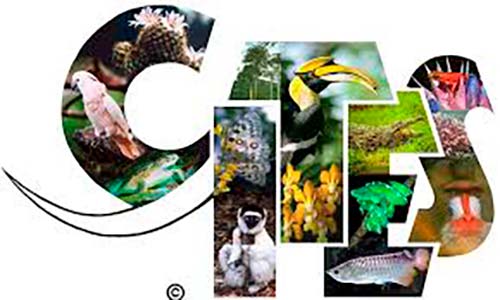
“The extensive information currently available on the danger of extinction of many symbolic species, such as the tiger and the elephant, might suggest that the need for such a convention was obvious. However, at the time when the CITES ideas were first sketched out in the 1960s, the international debate on the regulating wildlife trade in favor of conservation was relatively new. In hindsight, the need for CITES is undoubted. It is estimated that annually international wildlife trade amounts to billions of dollars and affects hundreds of millions of specimens of animals and plants.”
Source: www.cites.org.
What is being done to recover the Borneo rainforest?
Greater consumers of wood
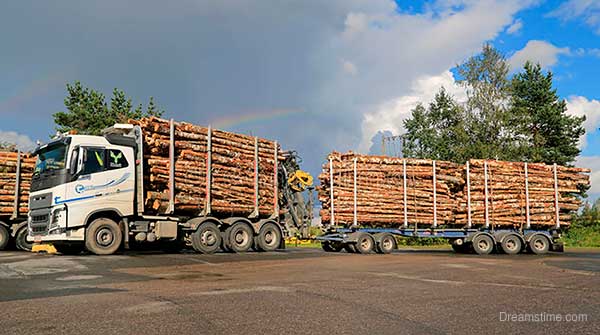
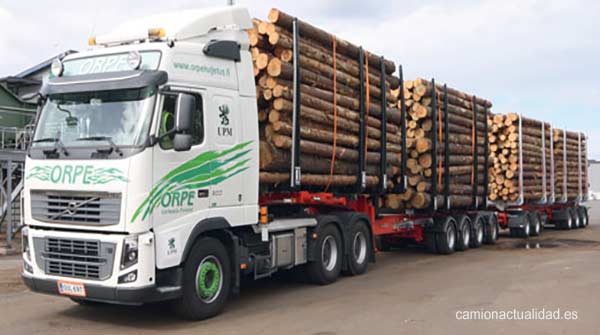
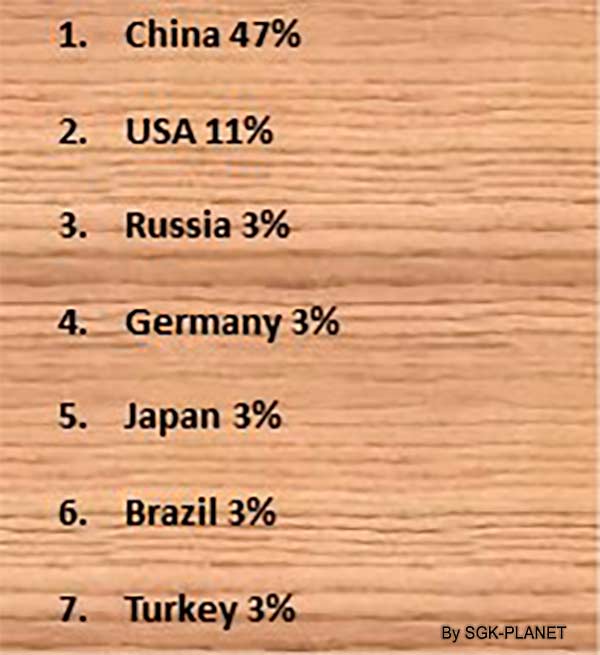
Amaizing video
Continued imports of illegal Cambodian timber from Vietnam
Kilometers of trucks loaded with wooden logs waiting to be embarked on the Mekong River. Apparently they come from the forests of Laos and Cambodia, located among the ten most deforested countries.
Why humans love wood

“Wood is one of the finest materials that never go out of style. It is an inspiration for all lovers of architecture, because it is both modern and elegant. It’s like the little black dress in a woman’s closet. It is bold and influential and establishes a connection between man and the environment. It is warm and familiar, and most of the time, this is a very important issue, especially when it comes to choosing the perfect decoration for your home, the place where you will spend some time (…)”.
Source: cmcarpinteria.com
It’s time to reflect
The fever for the wood goes in increase and the cutting of trees accelerates. The forests are being depleted by the hostile deforestation they are undergoing. Ending the trees has serious consequences, not only local ones, since its effects reach far away places and they go through the planet like a silent plague. Droughts, desertification and shortage of drinking water are acquiring serious global characteristics, as well as mega forest fires, more and more frequent, and in various places. Forests help to remove CO2 from the atmosphere. Burning them has a double negative effect, they stop working as lungs of the planet and add more carbon dioxide to the air, increasing the greenhouse effect and global warming. We are facing a perverse vicious circle, where the fires produce more heat and heat more fires. There is much talk about the emission of gases from automobile traffic, but much less is said about what is happening in the jungles and forests. It is time to legislate on the matter, exert more pressure on the responsible groups and carry out educational campaigns to reduce the consumption of wood.
The world must not allow the Amazon to be another Borneo
The rainforest of the Amazon goes by the same road as Borneo, with the aggravating circumstance that its surface is six times greater. The catastrophe that would mean not being able to stop the action that is taking place in the huge South American rainforest is unimaginable. If it is not possible to stop the damage to the lung of the world we could witness permanent desertification and drought in the Amazon itself, then it would spread south from the Andean mountain range to Tierra del Fuego and north from the Caribbean area to North America. Finally its influence would acquire global character. It is everyone’s duty to avoid it.
